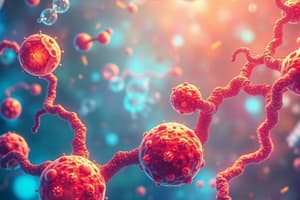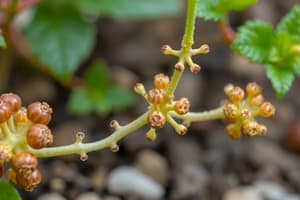Podcast
Questions and Answers
Describe how energy flows from the sun to plants to animals and how energy is transformed from one form to another.
Describe how energy flows from the sun to plants to animals and how energy is transformed from one form to another.
Plants absorb sunlight, make sugars, and release oxygen; animals eat the plants and get energy from them.
Match the following terms with their definitions:
Match the following terms with their definitions:
Catabolism = The process of enzymes breaking down large molecules into smaller pieces Anabolism = The process of enzymes building large molecules Exergonic = Release energy into the environment when they occur; tend to be catabolic Endergonic = Require an input of energy to happen and store energy; tend to be anabolic
Explain how ATP releases energy and powers other reactions in a cell.
Explain how ATP releases energy and powers other reactions in a cell.
Energy released in an exergonic reaction is used to power other endergonic reactions in the cell by forming high energy bonds with a new molecule.
Explain what an enzyme is and how it works.
Explain what an enzyme is and how it works.
Which factors affect enzyme activity?
Which factors affect enzyme activity?
Describe the overall structure of an angiosperm.
Describe the overall structure of an angiosperm.
What are the distinguishing characteristics of the flower in angiosperms?
What are the distinguishing characteristics of the flower in angiosperms?
What is the function of roots in plants?
What is the function of roots in plants?
What do shoots do for the plant?
What do shoots do for the plant?
Which of the following are macronutrients required by plants?
Which of the following are macronutrients required by plants?
Which of these performs photosynthesis in plants?
Which of these performs photosynthesis in plants?
Study Notes
Metabolism and Enzymes
- Catabolism breaks down large molecules into smaller pieces, releasing energy into the environment (exergonic).
- Anabolism builds large molecules from smaller ones, requiring energy input (endergonic).
- ATP releases energy by breaking its high-energy bonds, powering other reactions within a cell.
- Enzymes are proteins that speed up chemical reactions by bringing substrates to their active sites, facilitating bond breaking or formation.
- Enzyme activity is affected by:
- Temperature: influencing the movement of substrates and enzymes.
- pH: affecting an enzyme's shape and reactivity.
Plants as a Fuel Source: Plant Structure and Function
- Angiosperms are flowering plants, with distinct structures:
- Flowers: responsible for sexual reproduction, producing fruits.
- Roots: absorb water and nutrients from the soil, anchor the plant, and store carbohydrates.
- Adventitious roots: grow from the shoot system, providing extra support or anchoring.
- Pneumatophore roots: specialized roots for gas exchange.
- Storage roots: store carbohydrates.
- Shoots: harvest light and carbon dioxide for photosynthesis and transport water upwards.
- Stems: vertical aboveground structures with nodes (leaf attachments) and internodes.
- Herbaceous stems: exhibit vertical growth, without bark.
- Woody stems: exhibit vertical and outward growth, forming bark.
- Leaves: large surface area for photosynthesis.
- Stems: vertical aboveground structures with nodes (leaf attachments) and internodes.
- Plants with a large surface area to volume ratio are more efficient at absorbing sunlight, water, and nutrients.
- Essential Elements are necessary for plant growth and reproduction.
- Macronutrients: needed in large amounts (C, H, O, N, S, P, K, Ca, Mg).
- Micronutrients: needed in small amounts (Cl, Fe, Mn, B, Zn, Cu, Ni, Mo).
- Soil can be modified to support plant growth by adjusting its composition and nutrient content.
Photosynthesis
- Photosynthesis is the process of converting light energy into chemical energy in the form of sugars.
- It happens in the chloroplasts of plant cells.
- The light-dependent reactions capture light energy and convert it to chemical energy stored in ATP and NADPH.
- The light-independent reactions (Calvin cycle) use ATP and NADPH to fix carbon dioxide into sugars.
Respiration
- Cellular respiration is the process of breaking down sugars to release energy in the form of ATP.
- It occurs in the mitochondria of cells.
- Glycolysis breaks down glucose into pyruvate, generating a small amount of ATP.
- The Krebs cycle further oxidizes pyruvate, releasing CO2 and generating electron carriers.
- Electron transport chain uses electron carriers to pump protons across a membrane, creating a proton gradient that drives ATP synthesis.
Plant Adaptations
- C4 plants have adapted to hot, dry environments by concentrating CO2, reducing photorespiration and increasing photosynthetic efficiency.
- CAM plants also adapt to arid environments by opening their stomata at night to collect carbon dioxide and store it for use during the day.
Food Sources from Plants
- Plant-based foods provide essential nutrients including carbohydrates, proteins, fats, vitamins, and minerals.
- Legumes are important sources of protein, fiber, and iron.
- Grains are good sources of carbohydrates and fiber.
- Fruits and vegetables provide vitamins, minerals, and antioxidants.
Studying That Suits You
Use AI to generate personalized quizzes and flashcards to suit your learning preferences.
Related Documents
Description
Explore the intricate processes of metabolism and the role of enzymes in biological reactions. Additionally, learn about the structure and function of plants, particularly angiosperms, and how they convert energy. Test your knowledge of these essential biological concepts.




